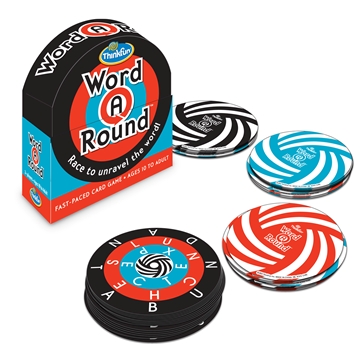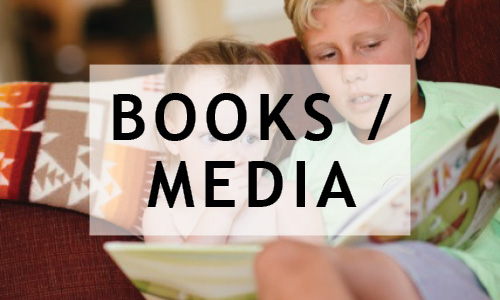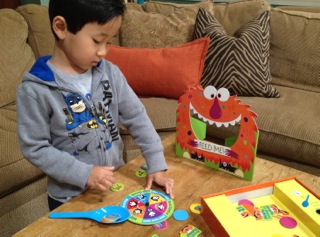 Turn off the TV? Set aside the iPad? Give up video games? That’s just what millions of people will be doing April 29-May 5 as they turn off screens and turn on life. We all see our kids pick up information and dare we admit “learn” from a TV show or ABC app but what are they missing while they watch or tap a screen?
Turn off the TV? Set aside the iPad? Give up video games? That’s just what millions of people will be doing April 29-May 5 as they turn off screens and turn on life. We all see our kids pick up information and dare we admit “learn” from a TV show or ABC app but what are they missing while they watch or tap a screen?
Children learn language through social interaction: babbling back and forth with a parent or caregiver, imitating words heard within the context of their day, combining words into first little sentences to make their needs known, or engaging in conversation about their day. What’s the best environment to learn language?
Babies benefit from a quiet setting since they have more difficulty distinguishing foreground sounds (like calling their name) from background noise (TV, music or loud noises). Since infants are capable of hearing small distinctions between sounds, providing an environment with a quiet background allows babies to be amazing little scientists and decipher language. Toddlers learn from multiple repetitions of a word as they start to speak their first word around 1 year of age, using combinations like “blue ball” or “more milk by 2 years of age.
A popular study by Hart and Risley found that the number of words spoken to a child from 1-2 years of age was linked to language accomplishment at age 3. Many studies have suggested that watching television, a passive activity, impedes learning by inhibiting a child’s opportunity for verbal interaction. A recent study published in the Archive of Pediatrics and Adolescent Medicine reported that when parents get drawn into the TV-watching too, interaction drops and fewer words are spoken, affecting parent-child communication and language learning.
That being said, I always counsel parents about setting limits and finding a balance for their family. I’ve been in homes where parents allowed no TV and others where there was a TV on in many rooms as background noise. I understand the benefits of having a child occupied while we start dinner or just need some down time, but be informed on the content available. Play the video games, watch the shows with them and set limits, allowing plenty of free play time to exercise language and learning.
Feeling a little anxious about how to fill the time during Screen-Free Week? Here are some suggestions to keep you thoroughly engaged with family and friends:
Play a game:
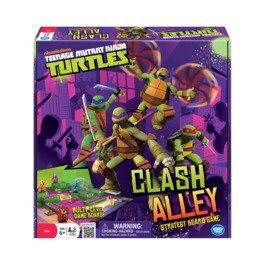
Kids love Teenage Ninja Turtles Clash Alley Strategy Board Game by Wonder Forge as they slip into the role of Donatello or Michelangelo, running, climbing and leaping across the 3-D warehouse board. The language of math prevails as kids help each other add up attack points, discuss greater and less than and plan strategy to complete their mission. This is an excellent first strategy game for kids 7 and up.
I never knew reading in circles could be so much fun! Players race to unravel the word and shout it out to win a card. WordARound by Thinkfun is addictive as players strengthen spelling, reading, language and vocabulary.
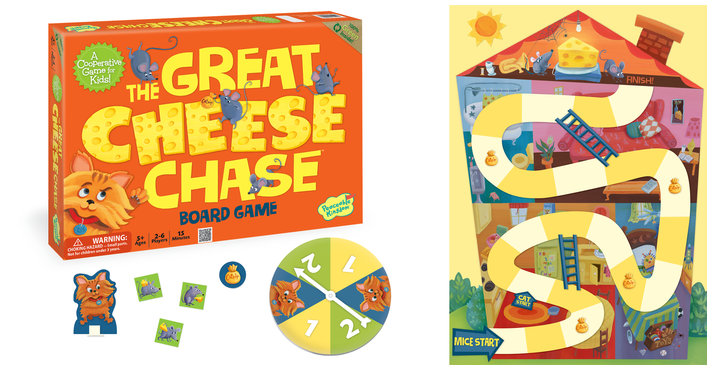 The race is on in the The Great Cheese Chase by Peaceable Kingdom, as the three mice scamper up to the attic for a large wedge of cheese with Tiger the Cat on their heels. The learning never stops in Peaceable Kingdom’s cooperative games. Along with following directions, cooperating, and making group decisions, players are building language skills as they discuss strategy options, explain the reasoning, and encourage each other to make the best move.
The race is on in the The Great Cheese Chase by Peaceable Kingdom, as the three mice scamper up to the attic for a large wedge of cheese with Tiger the Cat on their heels. The learning never stops in Peaceable Kingdom’s cooperative games. Along with following directions, cooperating, and making group decisions, players are building language skills as they discuss strategy options, explain the reasoning, and encourage each other to make the best move.
 Invite your toddler to play a stacking game with Racing Round Stacking Pyramid by Janod. There is so much to talk about as you describe the gorilla, lion, giraffe or duck, careening down the road in their little vehicles, of course wearing their helmets. Match numbers, colors and shapes as you continue the path.
Invite your toddler to play a stacking game with Racing Round Stacking Pyramid by Janod. There is so much to talk about as you describe the gorilla, lion, giraffe or duck, careening down the road in their little vehicles, of course wearing their helmets. Match numbers, colors and shapes as you continue the path.
Put on a puppet show:
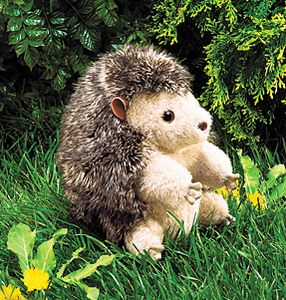 Folkmanis’ Little Hedgehog Puppet just joined his specially sized friends to delight little ones as they fit their hands into the animals, with a place for each finger. Tell your story as he wards off enemies by rolling up into a spiky ball, thanks to magnets that help his disguise.
Folkmanis’ Little Hedgehog Puppet just joined his specially sized friends to delight little ones as they fit their hands into the animals, with a place for each finger. Tell your story as he wards off enemies by rolling up into a spiky ball, thanks to magnets that help his disguise.
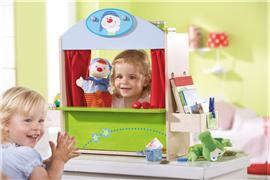 Set up the HABA Puppet Theater, open the little red curtains and the show begins. Practice storytelling builds language and prepares children for later reading and writing. This stage swivels into a store counter and 2 hanging boxes to extend the play for a little retail later.
Set up the HABA Puppet Theater, open the little red curtains and the show begins. Practice storytelling builds language and prepares children for later reading and writing. This stage swivels into a store counter and 2 hanging boxes to extend the play for a little retail later.
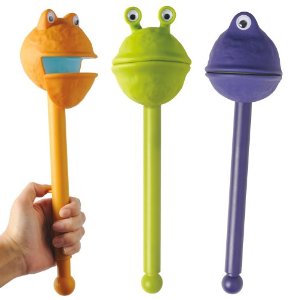 Thanks to Puppet-on-a-Stick’s unique design (by Educational Insights), kids can hold the character and operate his mouth while pulling down the lever on his stick body. Delighted to be able to independently operate these alien looking creatures, children jump right in to pretend play in the traditional sense–behind a sheet or curtain, popping up to announce or participate in the puppet show, or walk around like a puppeteer with the world as their stage.
Thanks to Puppet-on-a-Stick’s unique design (by Educational Insights), kids can hold the character and operate his mouth while pulling down the lever on his stick body. Delighted to be able to independently operate these alien looking creatures, children jump right in to pretend play in the traditional sense–behind a sheet or curtain, popping up to announce or participate in the puppet show, or walk around like a puppeteer with the world as their stage.
Join in your child’s play whether it be a board game, puppet show, or pretend play. Experiencing play with your child is priceless, and who knows, you may not even miss the screens.
The opinions expressed are solely those of the author. The above products were provided by their companies for review.
Sherry Artemenko M.S., CCC-SLP, speech language pathologist for over 35 years, is the founder of the PAL Awards (Play Advances Language) which distinguish the best new toys, games and books that have the DNA to build language skills in children. Through her private practice, Play on Words LLC and work in the schools, she has served kids for over 15,000 hours. Her popular blog, https://playonwords.com/ shares insights and tips with parents, educators and therapists on how to build speech and language skills.
